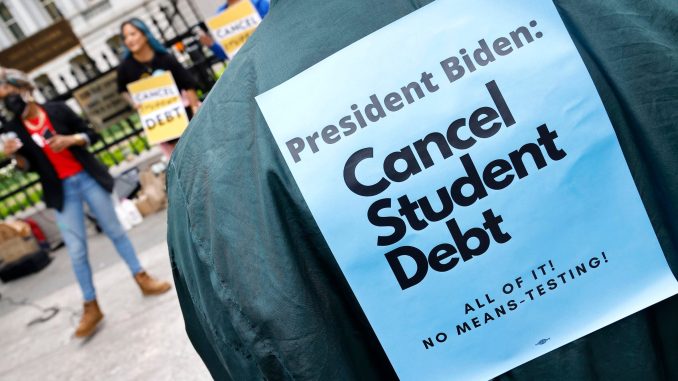
Instead of addressing the college debt crisis, the Biden administration has proposed new rules designed to punish for-profit colleges and stick taxpayers with billions of dollars in debt forgiveness.
Taxpayers deserve accountability from the Department of Education, not carrots and sticks that interfere with a free marketplace for higher education.
The rules, proposed last month, do two things. They make it easier for students to get out of their contracted obligations, enabling more mistakes and opening the door to fraud. And they crack down on proprietary colleges, even while claiming the new rules apply to all institutions.
The cost to taxpayers will be in the tens of billions of dollars. But that’s small change compared with the rest of the nearly $2 trillion in student debt that the rules do not affect.
A core problem with federal student loans is the artificially low interest rates. The easy money, whether a student wants to pursue engineering or women’s studies, enables colleges to raise tuition ever higher. Instead of doing something about the problem, the department is making it worse by making the easy money even easier.
The Department of Education proposes to ease eligibility for student loan forgiveness through changes to the Public Service Loan Forgiveness Program, disability discharges, and interest capitalization.
Public Service Loan Forgiveness Program forgiveness kicks in after 120 months of payment. But the department wants to count months of “payment” when a borrower is in deferment or forbearance (not actually paying). And despite the risks of bad data, the department proposes to “simplify” forgiveness by receiving data from federal agencies to automatically count eligibility for Public Service Loan Forgiveness or for disability discharges.
Disability discharges are charitable, but how do we know who qualifies? Disability fraud is rampant. Under the proposed rule, low-level medical professionals could declare whether someone is completely and permanently disabled, and the requirement for documentation in later years would be entirely removed.
As for ending interest capitalization, it’s mainly an optics gimmick.
For each $10,000 in debt, if you’re accruing 5% interest and you have a six-month forbearance, you have $250 in interest that no longer would be capitalized. The interest on that amount, which you no longer would accrue, comes to $12.50 per year. That’s almost enough to buy french fries in New York.
Meanwhile, the bad old days of punishing proprietary colleges for making a profit are coming back. The way it goes is this: First, make it easy to file a “borrower defense to repayment” claim on minimal evidence. That means a borrower claims he doesn’t have to repay the loan. Under the new rule, the department would accept group claims and presume full forgiveness.
Then, because the college might have to pay back the money that the students got for tuition, it is required to post an onerous letter of credit, proving that it has the money if needed. Finally, the letter of credit gets so large that no more credit is available, and the college goes out of business.
That’s the plan. It goes back to the early days of the Obama administration. By 2016, the Department of Education had required letters of credit 2,700 times, especially to squeeze for-profit colleges.
This time around, the department gives itself some new tools for oppression. One is the ability to reopen “at any time”—meaning forever—a borrower defense application that was denied. The lack of any time limit puts every institution under the gun forever for any claim, no matter how weak.
Another is the idea to start various timelines with the last date of attendance at the institution by the accuser. This produces the absurd result that a student who attended college in the 1970s and then returns to finish in 2023 could file a claim based on the institution’s promises in the 1970s.
While the department professes that the proposed rules would apply to nonprofit and public colleges as well, the narrative in the rule admits that for-profit colleges would be affected disproportionately—as intended.
How do the rules attack profit? For one thing, they ban recruiting tactics that are normal marketing in other sectors of the economy. What the department calls “aggressive” includes pressure to make a decision on the same day of an inquiry (just like any good salesman would do), or placing an “unreasonable emphasis” on the negative consequences of delaying a decision (of course, “unreasonable” will be defined by the department).
And the laughable ban on failing to reply to a prospective student’s request for more information is merely a ban on poor customer service.
Furthermore, the bans on “omission” of information give the department nearly unlimited discretion to punish colleges. The rules are written so generically that the department could penalize any college it wants. For example, the rules would ban omissions regarding “the availability of enrollment openings” or omissions “relating to the nature of the institution’s educational programs” or “the employability of the institution’s graduates.”
Finally, the department bans dispute resolution via internal dispute resolution or arbitration, and it prevents bans on class actions. The rule conditions federal student aid on the freedom of a borrower and an institution to enter into a mutually agreeable contract, and it even prevents institutions from enforcing their existing contracts.
Given how the department has treated propriety institutions in the past, I fully understand that they don’t trust the department to be a fair adjudicator, so they prefer other methods of resolution.
The Department of Education’s goal should be to address the student loan crisis, not make it worse or penalize profit.
Have an opinion about this article? To sound off, please email letters@DailySignal.com and we’ll consider publishing your edited remarks in our regular “We Hear You” feature. Remember to include the URL or headline of the article plus your name and town and/or state.

Be the first to comment